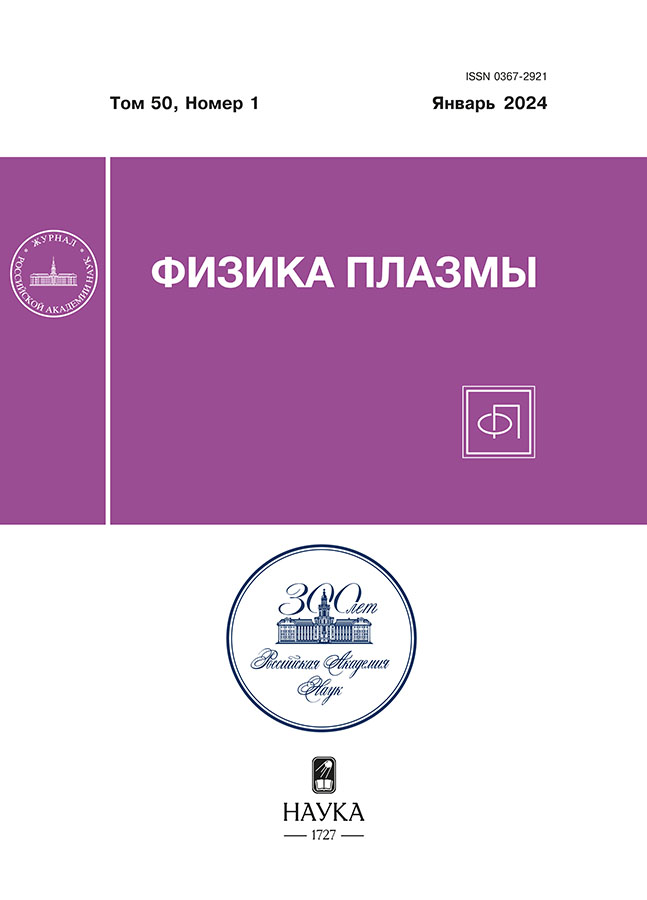Ignition of Self-Sustained Е×В Discharge; Ion Contribution to Understanding the Process
- Авторлар: Strokin N.A.1, Rigin A.V.1
-
Мекемелер:
- Irkutsk National Research Technical University
- Шығарылым: Том 50, № 1 (2024)
- Беттер: 134-143
- Бөлім: LOW TEMPERATURE PLASMA
- URL: https://cardiosomatics.ru/0367-2921/article/view/668841
- DOI: https://doi.org/10.31857/S0367292124010126
- EDN: https://elibrary.ru/SJDNTZ
- ID: 668841
Дәйексөз келтіру
Аннотация
We determined critical values for the ignition voltage and magnetic induction for a self-sustained plasma discharge in crossed electric and magnetic fields, both at inert gases and in their mixtures. As parameters that enabled to visualize igniting an E×B discharge, we used the ion current and the induction current derivative, and provided the temporal characteristics for the process. We found a double structure of the ion current (discharge current) during the ignition. The working media initial state for the discharge current first jump is a neutral gas, whereas the working media initial state for the second jump is plasma. A peak of ions originated within the near-cathode area is detected on the energy distributions of the ions obtained during the ignition. Also detected is a wide ion energy spectrum related to the discharge gap. We show a various discharge ignition character for Penning pairs, when the gas changes its role (main or admixture) in the mixture. The character is determined by features of forming the electric potential distribution in the near-cathode layer.
Толық мәтін
Авторлар туралы
N. Strokin
Irkutsk National Research Technical University
Хат алмасуға жауапты Автор.
Email: strokin85@inbox.ru
Ресей, Irkutsk
A. Rigin
Irkutsk National Research Technical University
Email: strokin85@inbox.ru
Ресей, Irkutsk
Әдебиет тізімі
- Brown S.C. Introduction to electrical discharges in gases (John Wiley & Sons, New York, London, Sydney, 1966). Available at: http://experimentationlab.berkeley.edu/sites/default/files/ Electrical-Discharges-In-Gases.pdf)
- Raizer Y.P. Gas Discharge Physics (Springer, Berlin, 1991). Available at: https://link.springer.com/book/9783642647604
- Gallo C.F. // IEEE Trans. Ind. Appl. 1975. V. IA-13. P. 739. doi: 10.1109/TIA.1975.349370
- Baranov O., Bazaka K., Kersten H., Keidar M., Cvelbar U., Xu S., Levchenko I. // Appl. Phys. Rev. 2017. V. 4. Р. 041302. doi: 10.1063/1.5007869
- Liu W., Zhang G., Jin C., Xu Y., Nie Y., Shi X., Sun J., and Yang J. // Appl. Phys. Lett. 2022. V. 121. Р. 073301. doi: 10.1063/5.0092988
- Abolmasov S.N. // Plasma Sourc. Sci. Technol. 2012. V. 21. Р. 035006. doi: 10.1088/0963-0252/21/3/035006
- Michiels M., Leonova K., Godfroid T., Snyders R., and Britun N. // Appl. Phys. Lett. 2022. V. 121. Р. 051603. doi: 10.1063/5.0096128
- Goebel D.M. and Katz I. FundamenAALs of Electric Propulsion: Ion and Hall Thrusters (John Wiley & Sons, Hoboken, New Jersey, 2008). Available at: https://descanso.jpl.nasa.gov/SciTechBook/series1/Goebel_cmprsd_opt.pdf.
- Keidar M. // Plasma Sourc. Sci. Technol. 2015. V. 24. Р. 033001. doi: 10.1088/0963-0252/24/3/033001
- Keidar М. and Robert E. // Phys. Plasmas. 2015. V. 22. Р. 121901. doi: 10.1063/1.4933406
- Xu Z., Lan Y., Ma J., Shen J., Han W., Shuheng H.U., Chaobing Y.E., Wenhao X.I., Zhang Y., Yang C., Zhao X., Cheng C. // Plasma Sci. Technol. 2020. V. 22. Р. 103003. doi: 10.1088/2058-6272/ab9ddd
- Townsend J.S. // J. Sci., Ser. 6. 1913. V. 26. P. 730. doi: 10.1080/14786441308635017
- Townsend J.S., Gill E.W.B. // J. Sci. Ser. 7. 1938. V. 26. P. 290. doi: 10.1080/14786443808562125
- Blevin H.A., Haydon S.C. // Aust. J. Phys. 1958. V. 11. P. 18. doi: 10.1071/PH580018
- Valle G. // Nuovo Cimento. 1950. V. 7. P. 174. doi: 10.1007/BF02781871
- Heylen A.E.D., Eng C. // IEE Proc. 1980. V. 127. P. 221. doi: 10.1049/ip-a-1.1980.0034
- Nikulin S.P. // Tech. Phys. 1998. V. 43. P. 795. doi: 10.1134/1.1259092
- Ellison C.L., Raitses Y., Fisch N.J. // IEEE Trans. Plasma Sci. 2011. V. 39. P. 2950. doi: 10.1109/TPS.2011.2121925
- Penning F.M. // Naturwiss. 1927. V. 15. P. 818. doi: 10.1007/BF01505431
- Penning F.M. // Z. Phys. 1929. V. 57. P. 723. doi: 10.1007/BF01340651
- Penning F.M. // Physica. 1934. V. 1. P. 1028. doi: 10.1016/S0031-8914(34)80297-2
- Strokin N.A., Bardakov V.M. // Plasma Phys. Rep. 2019. V. 45. P. 46. doi: 10.1063/1.4846898
- Bardakov V.M., Ivanov S.D., Kazantsev A.V., Strokin N.A. // Rev. Sci. Instrum. 2015. V. 86. 053501. doi: 10.1063/1.4920998
- Bardakov V.M., Ivanov S.D., Kazantsev A.V., Strokin N.A. // Instrum. Exp. Tech. 2015. V. 58. No. 3. P. 359. doi: 10.1134/S0020441215030045
- Lai S.T. // AIP Adv. 2020. V. 10. Р. 095324. doi: 10.1063/5.0014266
- Ohayon B., Wahlin E., Ron G. // J. Instrum. 2015. V. 10. Р. 03009. doi: 10.1088/1748-0221/10/03/P03009
Қосымша файлдар

















